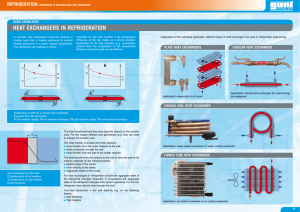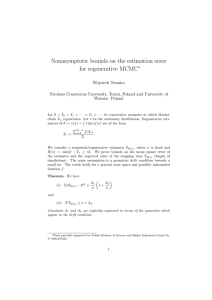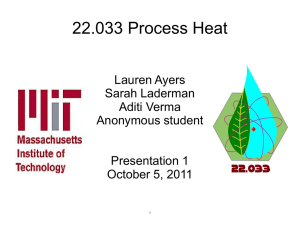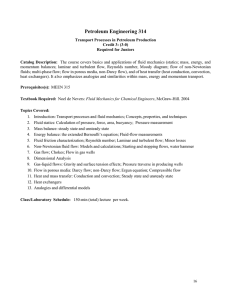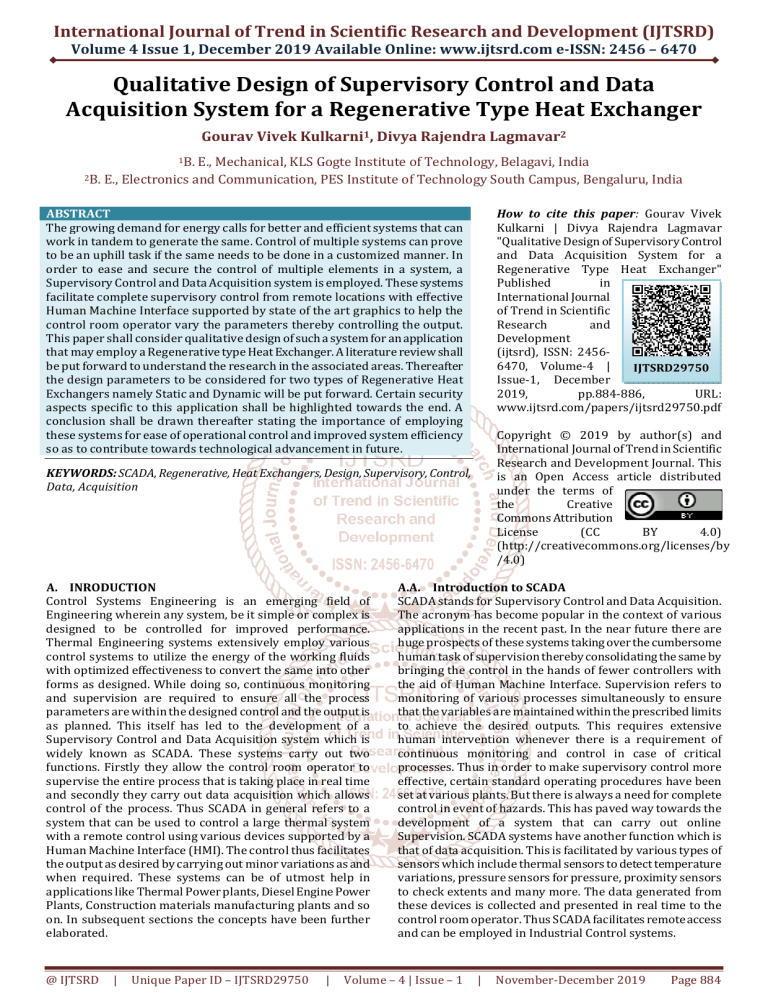
International Journal of Trend in Scientific Research and Development (IJTSRD)
Volume 4 Issue 1, December 2019 Available Online: www.ijtsrd.com e-ISSN: 2456 – 6470
Qualitative Design of Supervisory Control and Data
Acquisition System for a Regenerative Type Heat Exchanger
Gourav Vivek Kulkarni1, Divya Rajendra Lagmavar2
1B.
2B.
E., Mechanical, KLS Gogte Institute of Technology, Belagavi, India
E., Electronics and Communication, PES Institute of Technology South Campus, Bengaluru, India
How to cite this paper: Gourav Vivek
Kulkarni | Divya Rajendra Lagmavar
"Qualitative Design of Supervisory Control
and Data Acquisition System for a
Regenerative Type Heat Exchanger"
Published
in
International Journal
of Trend in Scientific
Research
and
Development
(ijtsrd), ISSN: 24566470, Volume-4 |
IJTSRD29750
Issue-1, December
2019,
pp.884-886,
URL:
www.ijtsrd.com/papers/ijtsrd29750.pdf
ABSTRACT
The growing demand for energy calls for better and efficient systems that can
work in tandem to generate the same. Control of multiple systems can prove
to be an uphill task if the same needs to be done in a customized manner. In
order to ease and secure the control of multiple elements in a system, a
Supervisory Control and Data Acquisition system is employed. These systems
facilitate complete supervisory control from remote locations with effective
Human Machine Interface supported by state of the art graphics to help the
control room operator vary the parameters thereby controlling the output.
This paper shall consider qualitative design of such a system for an application
that may employ a Regenerative type Heat Exchanger. A literature review shall
be put forward to understand the research in the associated areas. Thereafter
the design parameters to be considered for two types of Regenerative Heat
Exchangers namely Static and Dynamic will be put forward. Certain security
aspects specific to this application shall be highlighted towards the end. A
conclusion shall be drawn thereafter stating the importance of employing
these systems for ease of operational control and improved system efficiency
so as to contribute towards technological advancement in future.
Copyright © 2019 by author(s) and
International Journal of Trend in Scientific
Research and Development Journal. This
is an Open Access article distributed
under the terms of
the
Creative
Commons Attribution
License
(CC
BY
4.0)
(http://creativecommons.org/licenses/by
/4.0)
KEYWORDS: SCADA, Regenerative, Heat Exchangers, Design, Supervisory, Control,
Data, Acquisition
A. INRODUCTION
Control Systems Engineering is an emerging field of
Engineering wherein any system, be it simple or complex is
designed to be controlled for improved performance.
Thermal Engineering systems extensively employ various
control systems to utilize the energy of the working fluids
with optimized effectiveness to convert the same into other
forms as designed. While doing so, continuous monitoring
and supervision are required to ensure all the process
parameters are within the designed control and the output is
as planned. This itself has led to the development of a
Supervisory Control and Data Acquisition system which is
widely known as SCADA. These systems carry out two
functions. Firstly they allow the control room operator to
supervise the entire process that is taking place in real time
and secondly they carry out data acquisition which allows
control of the process. Thus SCADA in general refers to a
system that can be used to control a large thermal system
with a remote control using various devices supported by a
Human Machine Interface (HMI). The control thus facilitates
the output as desired by carrying out minor variations as and
when required. These systems can be of utmost help in
applications like Thermal Power plants, Diesel Engine Power
Plants, Construction materials manufacturing plants and so
on. In subsequent sections the concepts have been further
elaborated.
@ IJTSRD
|
Unique Paper ID – IJTSRD29750
|
A.A. Introduction to SCADA
SCADA stands for Supervisory Control and Data Acquisition.
The acronym has become popular in the context of various
applications in the recent past. In the near future there are
huge prospects of these systems taking over the cumbersome
human task of supervision thereby consolidating the same by
bringing the control in the hands of fewer controllers with
the aid of Human Machine Interface. Supervision refers to
monitoring of various processes simultaneously to ensure
that the variables are maintained within the prescribed limits
to achieve the desired outputs. This requires extensive
human intervention whenever there is a requirement of
continuous monitoring and control in case of critical
processes. Thus in order to make supervisory control more
effective, certain standard operating procedures have been
set at various plants. But there is always a need for complete
control in event of hazards. This has paved way towards the
development of a system that can carry out online
Supervision. SCADA systems have another function which is
that of data acquisition. This is facilitated by various types of
sensors which include thermal sensors to detect temperature
variations, pressure sensors for pressure, proximity sensors
to check extents and many more. The data generated from
these devices is collected and presented in real time to the
control room operator. Thus SCADA facilitates remote access
and can be employed in Industrial Control systems.
Volume – 4 | Issue – 1
|
November-December 2019
Page 884
International Journal of Trend in Scientific Research and Development (IJTSRD) @ www.ijtsrd.com eISSN: 2456-6470
There are five levels of SCADA which are as follows.
Level 0 refers to the Floor level where various sensors carry
out their task of data acquisition and various other actuators
that are controlled by remote carry out the task of actuation.
Level 1 comprises of the input output modules and electronic
circuitry for the control of the system.
Level 2 refers to the control system at the other end of the
Human Machine Interface which facilitates the control from a
designated control room.
Level 3 and 4 are mainly concerned with the planning and
scheduling of the activities of the process flow. Thus it is quite
evident that a SCADA system can be employed for efficient
control of systems using displays that indicate the process in
real time. For example boilers, heat exchangers, valves etc
can be represented pictorially on a screen and the controller
can input certain parameters which would then be converted
to signals and the actuation can take place in the machinery
with the help of various actuators by using Programmable
Logic Controllers (PLC) or Remote Terminal Units (RTU).
A.B. Regenerative Heat Exchangers
A heat Exchanger by definition is a device used to transfer
heat between two or more fluids. There are various
configurations in which heat exchangers are designed to
carry out heat transfer. This paper shall consider
Regenerative type Heat Exchanger. As the name itself
indicates, a regenerative heat exchanger initially stores heat
in a certain system and utilizes it at a later stage by
withdrawing the same. It is quite interesting to know how
this is facilitated. In order to know the same, an important
point regarding heat exchangers that needs to be kept in
mind is that there is no mixing of fluids that takes place. The
fluids are maintained in separate tubes and the process of
heat transfer takes place thereby.
In a Regenerative Heat Exchanger, heat from the hot fluid is
intermittently stored in a thermal storage before it is
transferred to the cold fluid. This means that whenever the
hot fluid is in action, the heat is trapped in certain material
and the same is withdrawn at a later stage. While doing so,
the Zeroth Law of Thermodynamics forms the basis for Heat
Transfer. Depending on the method by which heat from hot
fluid is stored, Regenerative Heat Exchangers are of two types
i.e. Static Regenerative Heat Exchangers and Dynamic
Regenerative Heat Exchangers. These shall be discussed in
subsequent sections.
B. Literature Review
In the paper titled SCADA applications in thermal power
plants by M. N. Lakhoua [1], the author has described the
application of SCADA on a larger scale in a Thermal Power
Plant. Various examples like counting system of natural gas,
supervision of pumps vibrations and supervision of heavy
fuel oil have been considered to elaborate the system
requirements.
In the paper titled "Fault Detection of an Industrial HeatExchanger: A Model-Based Approach" by Dejan Dragan [2],
the author has explained a model based approach towards
detection of faults in industrial heat exchangers. The model
considers effect of various input parameters on the working
of the industrial heat exchanger and problems caused due to
faults. It comments on the method of detection of faults in
heat exchangers.
@ IJTSRD
|
Unique Paper ID – IJTSRD29750
|
The paper titled “Application of Predictive Control to a Heat
Exchanger" by Laszczyk P. et al [3], describes technical
considerations to be taken into account while designing a
Heat Exchanger system with predictive control. The
predictive control involves consideration of variables like
flow and temperature to extrapolate the effectiveness of the
heat exchanger.
C. Types of regenerative Heat Exchangers
As discussed earlier, there are two types of Regenerative Heat
Exchangers. The division has been done on the basis of
overall system requirements. Applications where moving
parts can be accommodated employ dynamic type while
those which cannot go for the static type.
C.A. Static Regenerative Heat Exchangers
In a Static type Regenerative Heat exchanger, the heat of the
hot fluid is stored in certain porous material like steel wool or
rock. Once the hot fluid is passed through the porous
material, the heat transferred from the hot fluid to the porous
material is stored for the required time duration. When the
need for passing the cold fluid arises, the same is made to
pass through the porous material which makes the heat to be
transferred from the porous material to the cold fluid thereby
increasing its temperature and effectively using the heat
which was about to be lost if not utilized. It may be noted that
both the fluids never flow through the porous material at the
same time thereby avoiding mixing with each other. One of
the major applications of this type include utilization of
concentrated solar energy for power generation at night.
Fig.1. Static Regenerative Heat Exchanger
C.B. Dynamic Regenerative Heat Exchangers
In this type of Heat Exchanger, instead of a static pile of
porous material, a wheel made up of porous material is used.
A baffle plate is used to avoid mixing of the fluids. During first
half of the rotation, the hot fluid flows over a part of the
porous wheel, While rotating in this manner, the wheel picks
up the heat from the hot fluid. During the next half of the
rotation, the picked up heat is transferred to the cold fluid.
Thus due to the continuous movement of the porous wheel,
the type of heat exchanger has been named as dynamic type
heat exchanger as depicted in Fig 2.
Fig2. Dynamic Regenerative Heat Exchanger
Volume – 4 | Issue – 1
|
November-December 2019
Page 885
International Journal of Trend in Scientific Research and Development (IJTSRD) @ www.ijtsrd.com eISSN: 2456-6470
D. Qualitative design of SCADA for Regenerative Heat
Exchangers in Industrial Applications
The key applications include small scale power generation
units. In these units, it is required that a finite number of
process parameters are controlled by supervisory control.
The same shall be discussed in subsequent sections.
Emphasis shall be laid on the system requirements and
qualitative effect of certain key process variables on the
effectiveness of the heat exchanger.
D.A. Qualitative Design of SCADA for Static type
Regenerative Heat Exchangers
The control parameters in this type of Heat Exchanger
include mass of the porous material, maximum temperature
that can be withstood by the porous material, mass flow rate
of the hot fluid, mass flow rate of the cold fluid, duration of
contact flow of the hot fluid and time of flow of the cold fluid.
A SCADA system would comprise of a pictorial representation
of the system along with graphics to enable system control
from the Human Machine Interface. Each of the mentioned
parameter shall be considered and executive control shall
now be discussed.
While calculating the heat retention capacity of the Heat
exchanger, a certain minimum mass of the porous material
needs to be maintained. This is because reduction in it would
lead to lesser heat retention thereby reducing the
effectiveness of the heat exchanger. Loss of mass may take
place due to aggravation in flow parameters. Thus load
sensors located at the core of the heat exchanger ensure
constant mass. There is a certain threshold to the maximum
temperature that can be attained by the porous material.
Suitable warning signals need to be generated when the
temperature would cross safe working limits. Mass flow rate
of the hot and cold fluid can be controlled by using flow
control valves. This is a critical performance variable as it
contributes to effective heat transfer between the hot and the
cold fluid. Actuators can be used to control these valves and
appropriate employment of sensors facilitates data
acquisition. The flow duration is critical because if not
controlled, it can lead to mixing of the fluids which would be
undesirable. Thus the SCADA system should have control
over the mentioned parameters improve the effectiveness of
the heat exchanger.
D.B. Qualitative Design of SCADA for Dynamic type
Regenerative Heat Exchangers
The control parameters in this type of Heat Exchanger
include angular velocity of the porous wheel, mass of the
wheel, maximum temperature that could be withstood by the
porous wheel, mass flow rates of hot and cold fluids and
duration of contact flow of hot and cold fluid. Similar to the
Static type the SCADA system would comprise of a pictorial
representation of the system along with graphics to enable
system control from the Human Machine Interface. Each of
the mentioned parameter shall be considered and executive
control shall now be discussed.
Rotational or angular velocity of wheel needs to be controlled
using motor control. This is an essential performance
parameter because for effective heat transfer, the fluid needs
to be in contact with the wheel for a certain duration. This
@ IJTSRD
|
Unique Paper ID – IJTSRD29750
|
duration is governed by the angular velocity of the wheel.
Accelerometers can be employed to regulate the angular
velocity and suitable alarm systems can be employed to warn
in event the velocity crosses the working limits. The mass of
the wheel governs the specific heat capacity of the material
and should ideally be constant to maintain the effectiveness
of the system. Load sensors can facilitate the required service
in this regard. The maximum temperature limit needs to be
checked from time to time because in case of dynamic
systems, due to rotation, there is certain additional heat that
needs to be accounted for which may be generated due to the
incoming energy to rotate the wheel. The mass flow rates of
hot and cold fluids can be controlled by flow controlled valves
and actuators similar to that in static type. The contact
duration in this case plays an important role because due to
rotation, there is continuous motion and the effective time is
less. This can be countered by designing for optimized wheel
diameter and angular velocity.
E. Security concerns and their effects in the context of
SCADA for Regenerative Heat Exchangers
A major security concern in the field of Thermal Engineering
is system failure due to malware attack or arbitrary efforts by
individuals to cause damage. In the case of Regenerative heat
exchangers, the system needs to made fool proof by providing
adequate standard operating procedures and checking the
adherence to the same by periodic assessments.
Malware attacks can cause serious deviations in the
performance of the system thereby leading to wastage of
energy that could have been harnessed. Such events should
be avoided to the best possible extent by effective and secure
design of systems.
Conclusion
Thus it can be concluded that in order to establish control
over a wider range of systems, SCADA systems can be
employed. These systems can facilitate accurate supervision
and allow the control room operator to control the entire
plant from a single remote location. Use of Human Machine
Interface and graphics can make the system more user
friendly and employable thereby leading to technological
advancement by a single point control. The qualitative design
concepts pave way towards a new area of research wherein
SCADA can be effectively employed to facilitate the working
of Static as well as Dynamic type Regenerative Heat
Exchangers.
References
[1] M. N. Lakhoua, "SCADA applications in thermal power
plants", International Journal of the Physical Sciences
Vol. 5(6), pp. 1175-1182, June 2010, pp 1175 - 1182
[2] Dejan Dragan, "Fault Detection of an Industrial HeatExchanger: A Model-Based Approach", Strojniški
vestnik - Journal of Mechanical Engineering 57 (2011)
6, pp 477-484
[3] Laszczyk P. Richalet J. (1999), “Application of
Predictive Control to a Heat Exchanger”, Dynamic
Control and Management Systems in Manufacturing
Processes - Techniques for Supervisory Management
Systems (preprints, ed. D. Matko and G. Mušič), Bled,
Slovenia
Volume – 4 | Issue – 1
|
November-December 2019
Page 886



